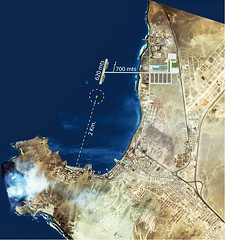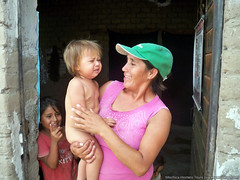Lost city of Cerro Azul
When the Incas arrived in the Cañete valley they found it fiercely defended by the Guarco (Huarco) people who lived there. It took future emperor Túpac Yupanqui years to subdue them, even going as far as to temporarily recreate the imperial capital of Cusco nearby as a base to attack from, moving the empire’s army there in the process. There were Huarco fortresses dotted across the fertile valley, and these fiercely defensive people had 20,000 warriors at their disposal, reading to die for their freedom – but life for the Huarco wasn’t always like this.

View from ruins to sea
Jutting out into the Pacific Ocean in what is now the port town of Cerro Azul is a rocky outcrop with a sheer drop into the sea below. The land slopes down a little as you move away from the ocean before rising again to form a rocky hill.
Facing away from the hill in the dip between it and the upward slope to the edge of the cliffs, you have the sea, although not visible, in front of you.
The modern town, the pier and the wide bay is down the side of the slope to the right, all visible and picture perfect.
But to the left, in an amphitheatre formed by the cliffs on which a lighthouse sits and the tall dark brown hill, an area that also slopes down to the sea on the opposite side of the outcrop – are the remains of a once bustling, wealthy and important city in ancient times.

See anything?
Little is left now, this city has met the same fate as most others of the Peruvian coast that were made out of mud and sand brick. Time has taken its toll and the dozens of pyramid temples, walls and administrative buildings have taken on a ‘melted’ look. A keen eye can still make out the outlines of the many pyramids that surround you, a less keen eye can suffice with the literally tonnes of fragments of pottery, fishing nets and cloth that sit in the sands, sands that are obviously out of place on top of a rocky hill.
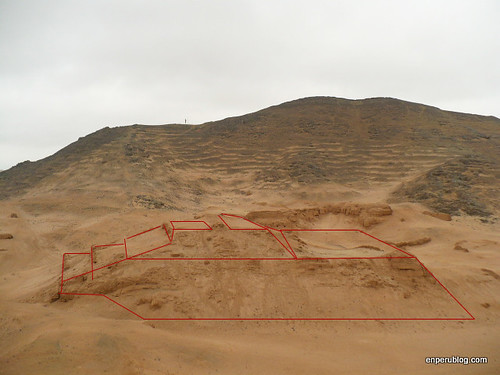
Huarco pyramid, now a pile of sand but once firm as concrete and painted brightly
Left unprotected by Peruvian authorities, some still come out here to dig holes in the huacas or pyramidal structures, and sometimes they find a mummy wrapped in fine cloth that they are able to sell. In the hole they leave destroyed the remains of bones and the lesser cloth that wrapped the funerary bundle.
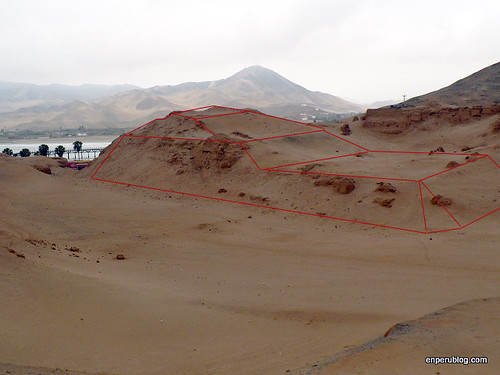
A pyramid that was once a temple
Only in Peru, land of a billion ruins and ancient cultures, would such an amazing archaeological site be left to deteriorate into powdery sand, and only in Peru can people with an interest in the past climb a hill to wander through a city hundreds of years old, hold shards of beautifully decorated pottery that should be priceless exhibits, and examine metres of ancient cloth woven before the arrival of the Spanish in Peru.
History
Guarco independence from the expanding Incas ended here around 1470 with celebrations in honour of the agreement reached with Túpac Yupanqui that was to see a partial retaining of sovereignty, a prize earlier awarded to the Chincha. It was all a deception though – as a religious ceremony took place honouring the sea, the Inca army moved in on the distracted Guarco, knocking out their defenses one by one and capturing their ceremonial centres and cities like Vilcahuasi and here in Cerro Azul. (Read about the conquest here)
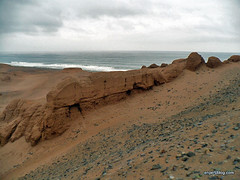
Old side wall of an impressive building
But just as the Guarco culture ended at Cerro Azul, it also began here. Where the ruins are now, a fishing community grew up. By trading fish with those further inland for grain, they became wealthy and dominant. A ceremonial and urban centre sprung up that had a peaceful influence over the Cañete valley and its rich fertile farmland. When aggressors from the mountains began encroaching on this fertile land, the people of the valley were forced to organise themselves into a confederation that was based in Cerro Azul. The Huarco confederation, as modern day investigators refer to it, fortified the valley and kept an army to defend it, forced by circumstance to become a defensive warrior people. Increasing wealth and power meant a small kingdom grew out of this confederation, with various cities and ceremonial sites, that stretched from Mala in the north, to the edge of Chincha territory in the south and to Lunahuaná at the foot of the Andes.
After the Inca Conquest
The eyes of the entire Inca empire were on the newly captured territory. To get the job done, Tupac Yupanqui had been forced to set up a seat of power, another Cusco, nearby and live there for years with his army and generals, and many of the Inca elite and their families. All for the pesky and minuscule kingdom of the Huarco.
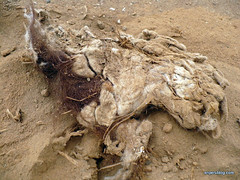
Ancient textiles on the surface
On entering Cerro Azul with his army, Tupac Yupanqui immediately ordered the construction of a magnificent and dominant building. Spanish chronicler Pedro Cieza de León explains that it was a “fortress”, though the Spanish often mistook sun temples and palaces at the tops of mountains and hills as “fortresses”.
The building was said to be the most spectacular and magnificent in all Peru. The brickwork was perfect, the doors impressive and the interior rooms and patios large. A perfect stone staircase is said to have led down the shear cliff to the sea, and the way in which the waves of the sea pounded at the cliffs, stairs and buildings left the observed astonished and unable to fathom how such a thing was constructed.
It sounds plausible considering Tupac Yupanqui had a huge workforce at his disposition, as well as the greatest minds from Cusco with him in his temporary capital.
Unfortunately, the bricks were not as huge as those at sites such as Sacsayhuamán and they were removed and taken to Lima during the early years of the Spanish colony there. In Lima they were used as foundation stones and material to rebuild after earthquakes. Whatever was left has probably fallen into the sea, spare a few bricks here and there:
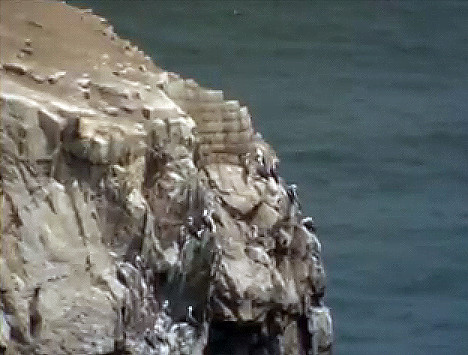
Inca Wall in Cerro Azul
Photos
Tags: cerro azul, huaca, huarco, incas, pyramids, ruins, tupac yupanki





